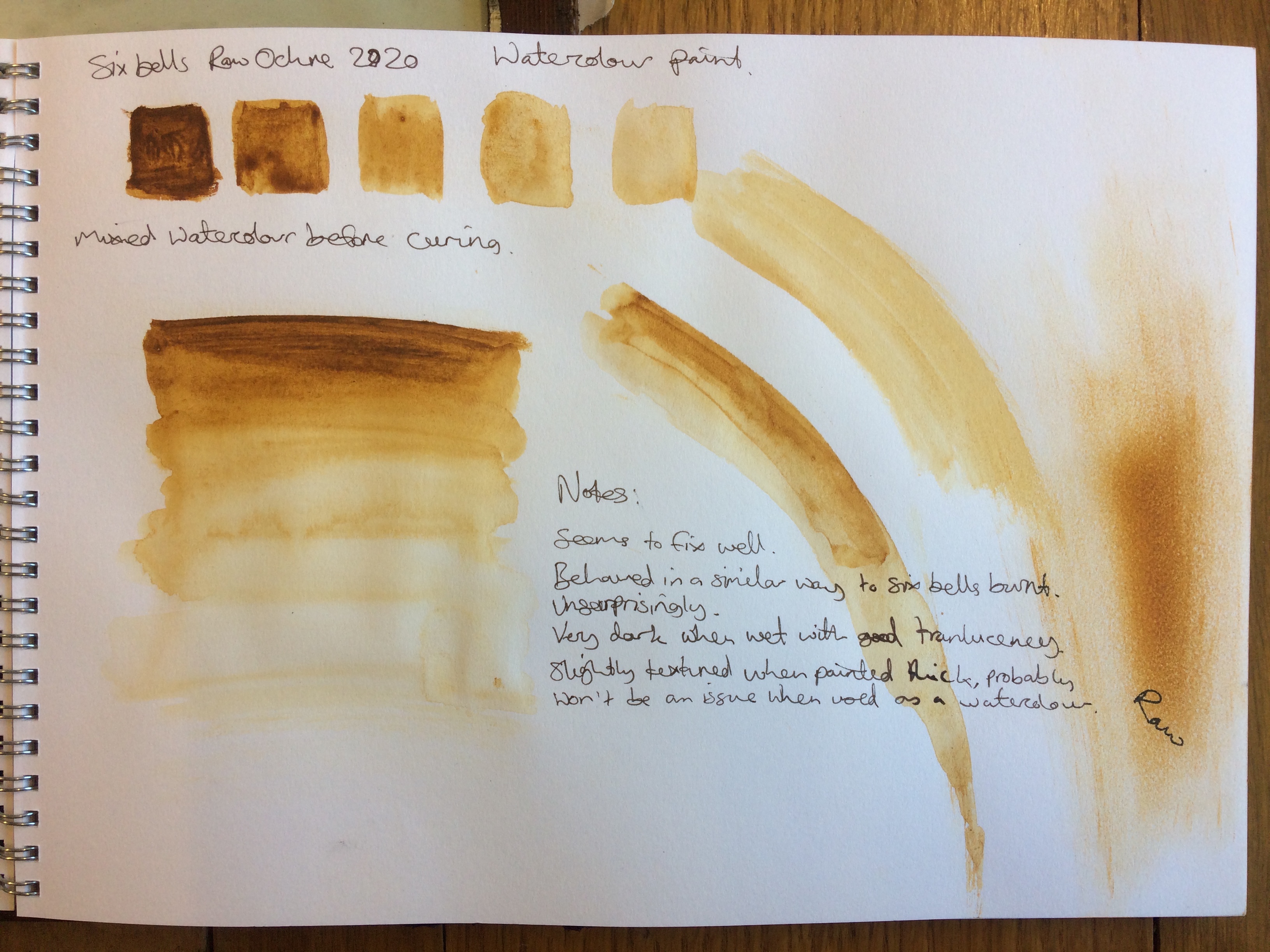Six Bells Red
On Friday 11th December 2020 during the Covid-19 pandemic Turning Landscape made and launched the worlds first ever exterior grade wall paint made from mine water ochre. Six Bells Red is now made in the former mining village of Six Bells. Alongside the wall paint Michael Harding (paints) made a series of 1000 40 ml tubes of high quality artists oil paint; Six Bells Burnt Ochre. These are for sale on this website, or if you make the journy to Six Bells we will give you a tube.
All proceeds from any sales we make are recycled back into the programme which supports local events, volunteers, production. If you run a public space, are a community group or project that would like to use either of these paints, you can apply to have some. Please email us.
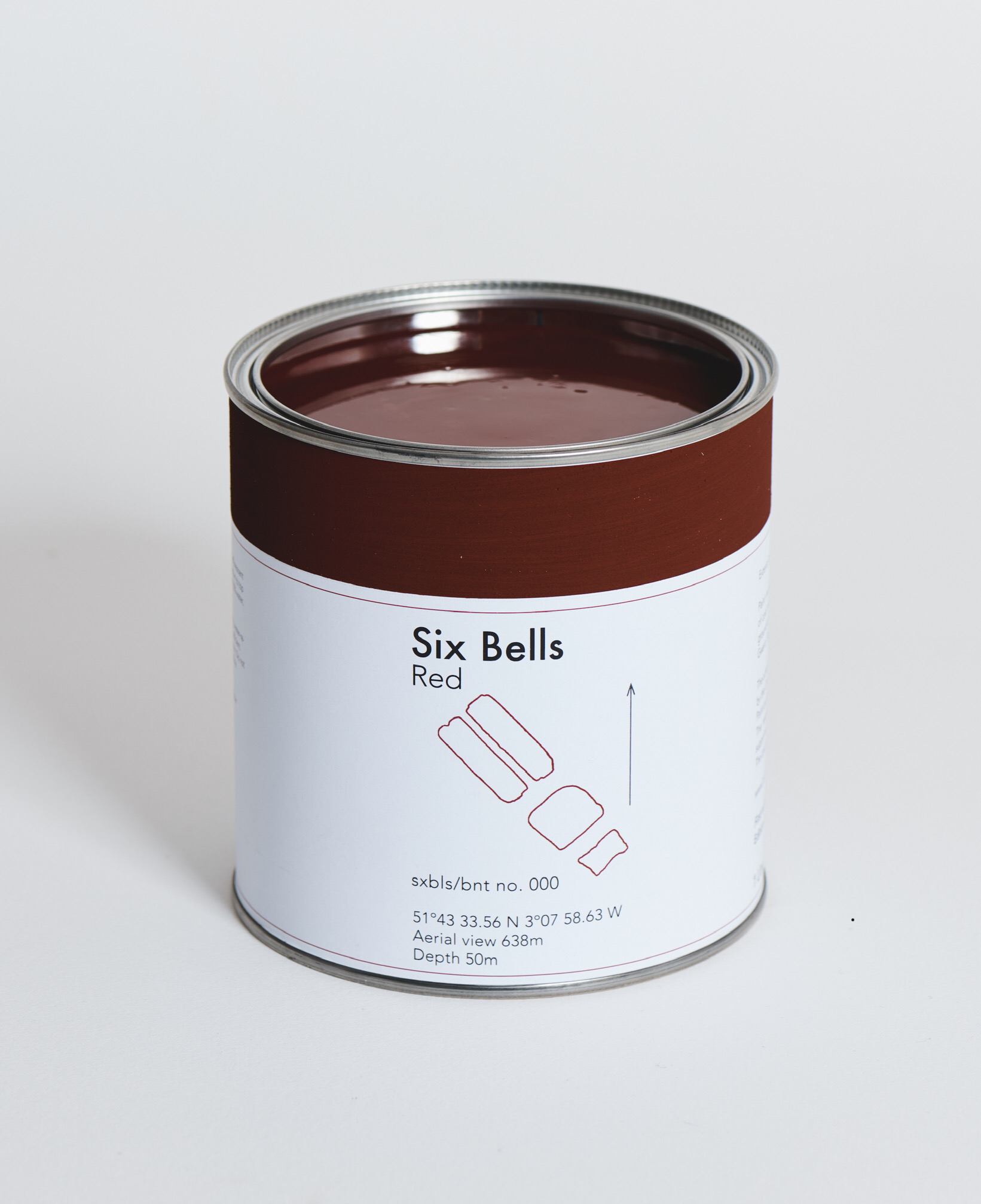
IL tin exterior grade wall paint Six Bells Red 1st ed. 2020
The pigment to make Six Bells Red has been specially created by burning the raw ochre at a specific temperature to create the distinctive red colour. This ochre forms as a residue during the treatment of polluting mine water making this a completely sustainable source of colour pigment.
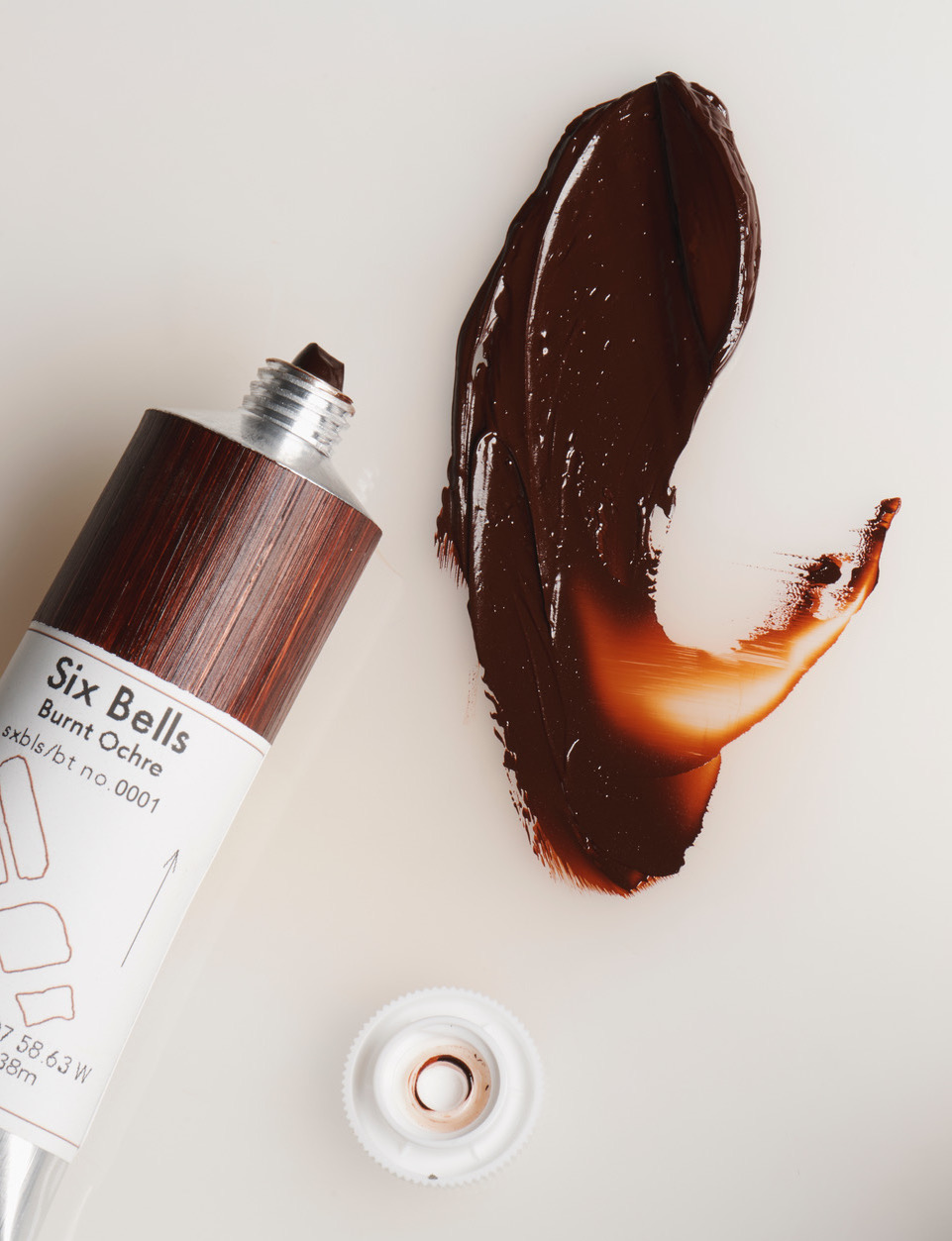
40ml tube of Six Bells Burnt Ochre artists’ oil paint 1st ed. 1000
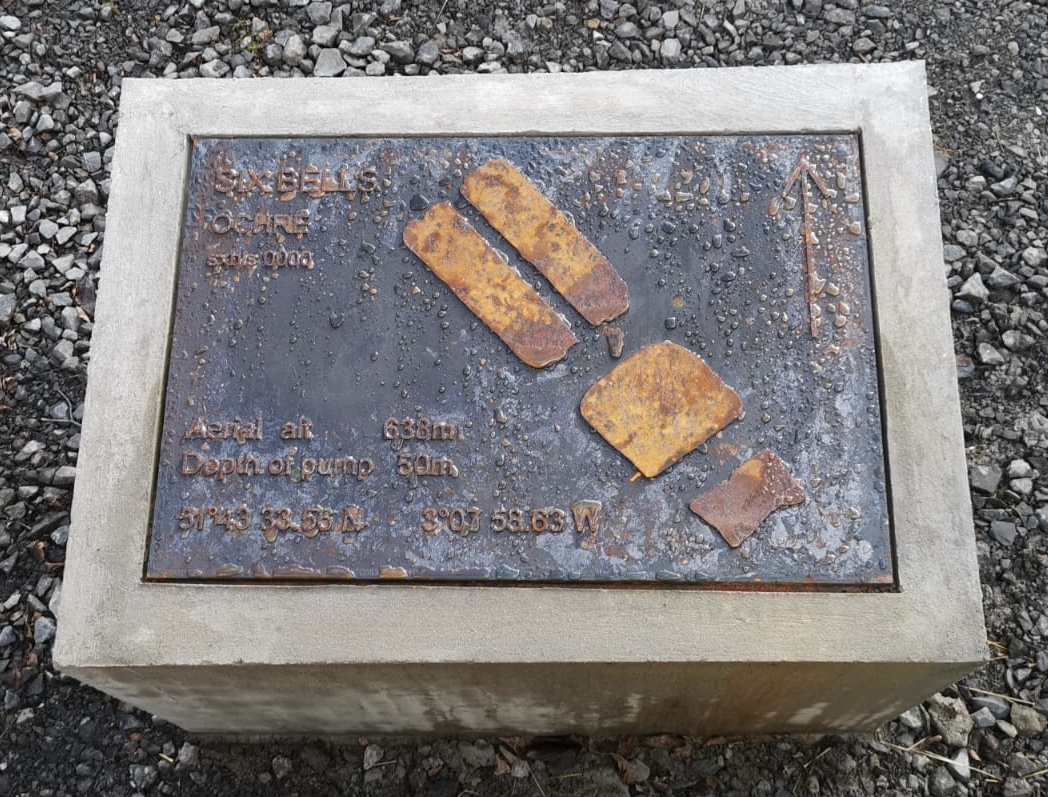
This cast iron marker plaque 2020 has been installed at the mine water treatment site designating the site as the permenat source of this colour.. The map will be visible from the footpath at the far north end of the perimeter fence.
Photos from the Launch Day..
Launch Event and Plaque Unveiling December 11th 2020 @ noon
The launch was held online with a physical presence at Six Bells Mine Water Treatment Scheme in South Wales, seeing the unveiling of a new public artwork - a map cast in iron marking, naming, claiming the site of the ochres’ formation.
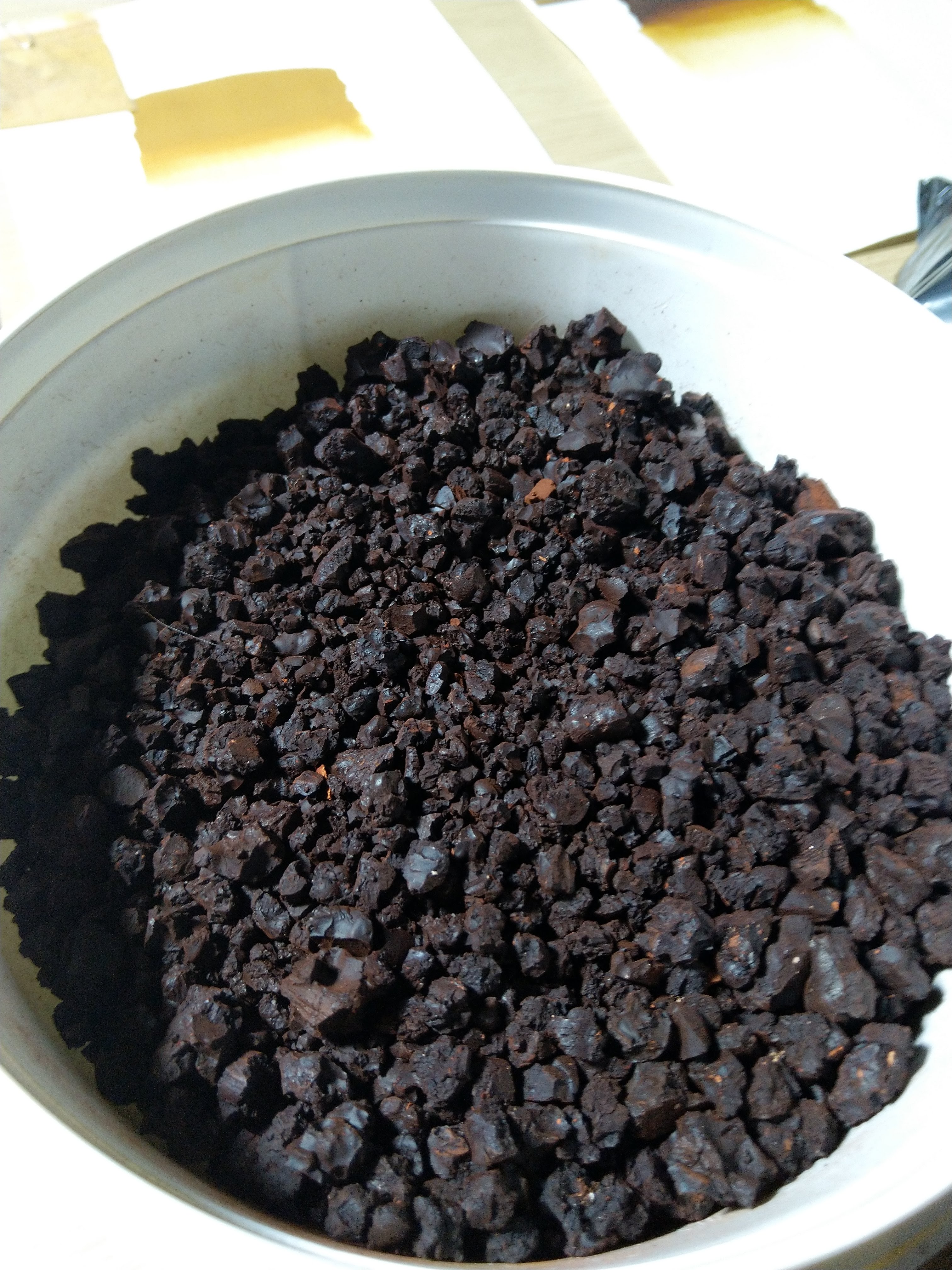
The ochre after it has been in the kiln, ready to be ground into pigment

Aerial photography of Six Bells mine water treatment scheme
The minewater treatment site viewed from Mynydd Llanhilleth
The minewater treatment site viewed from Mynydd Llanhilleth
Alun Davies MS unveils the plaque at Six Bells Mine Water Treatment Works
Dr Onya McCausland and former NCB surveyers and mine workers trace the route of minewater on vintage NCB plans in Jan 2020
A close up of the cast iron map the day after it was unveiled

The builders prepare to pour the concrete for the markers’s plinth
Onya in front of the newly painted wall
The wall in Ty Ebbw Fach that was painted live as part of the launch event on the 11 December 2020
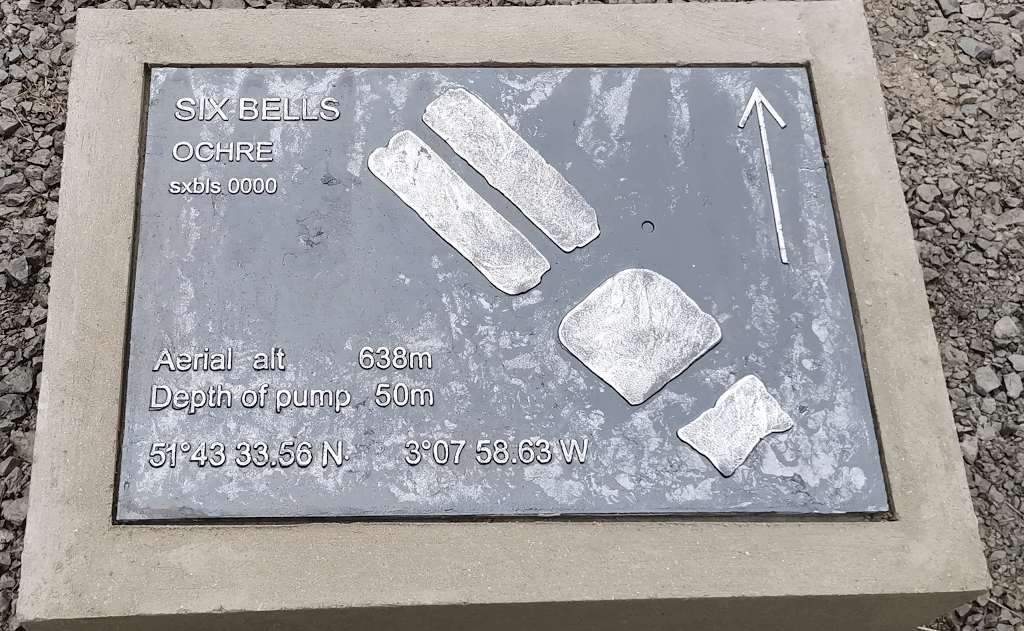
4K Video of Plaque Taken 23 December 2020
Background to Colour from the Mines
This project is led by artist Onya McCausland from UCL Slade School of Fine Art. Onya's practice develops an original and innovative approach to the role of the art object by making paint - including integrating its site of formation - as an artwork, in co-produced with manufacturers and members of the local ex-mining community. Paint in tubes and tins are considered as art objects and editioned for distribution and use by the public.
Onya McCausland developed the idea of recycling the coal mine sludge into paint while travelling around the country collecting samples of ochre from mine sites across former British coalfields in South Wales, Scotland, Lancashire and Yorkshire.
Further examples of Onya’s works can be found here: https://onyamccausland.com/ucl/
Six Bells is the first of five former coal mining sites around the UK that will take part in this project. The next one will be Saltburn near Middlesborough, followed by Cuthill West Lothian, Deerplay Hill in Lancashire, and finally back to South Wales Tan-y-Garn beside Ammanford.
It has been generously supported by the UK Coal Authority.
The project has been funded by the Leverhulme Trust, the Slade School of Fine Art and UCLInnovation & Enterprise, with support from Michael Harding.

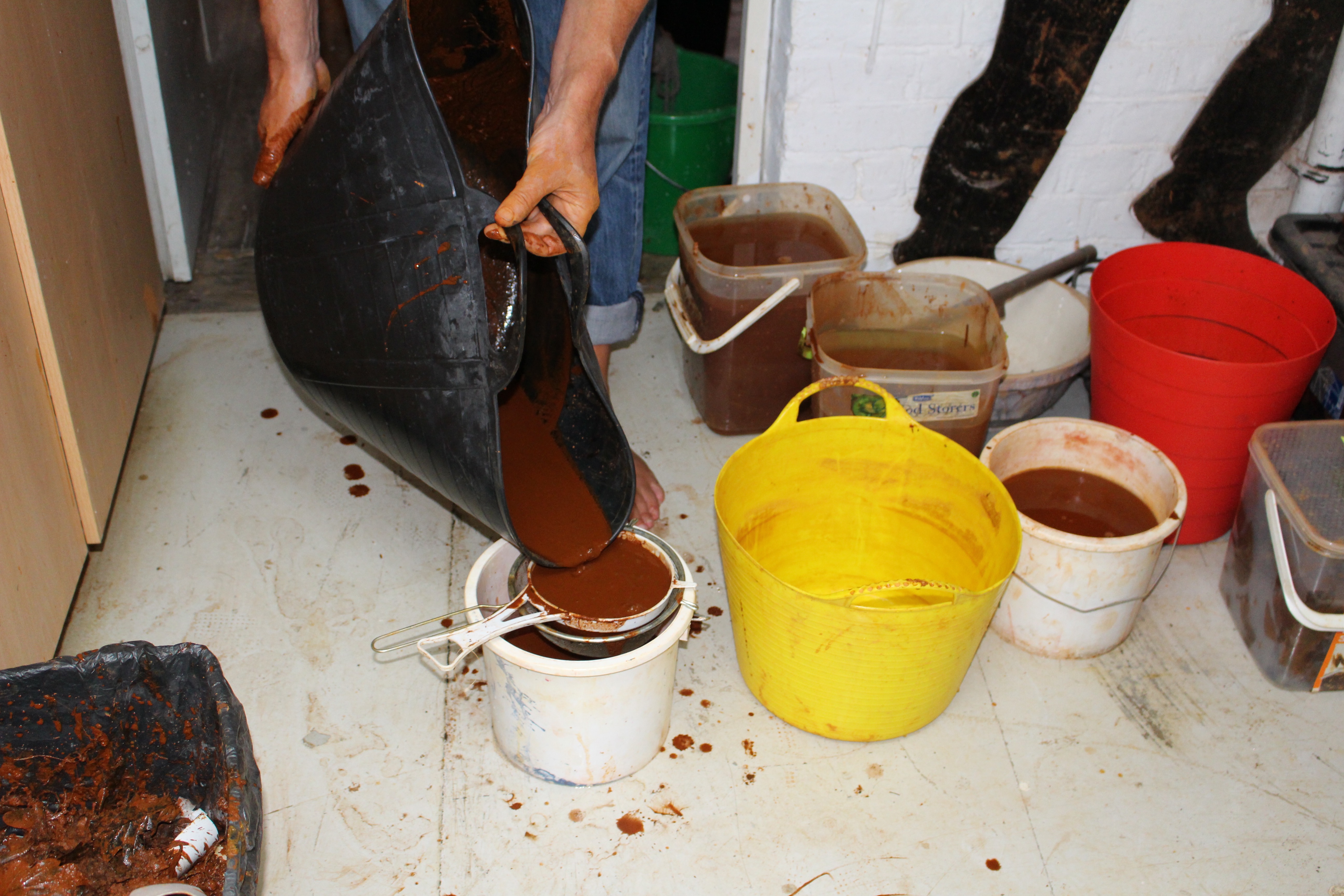

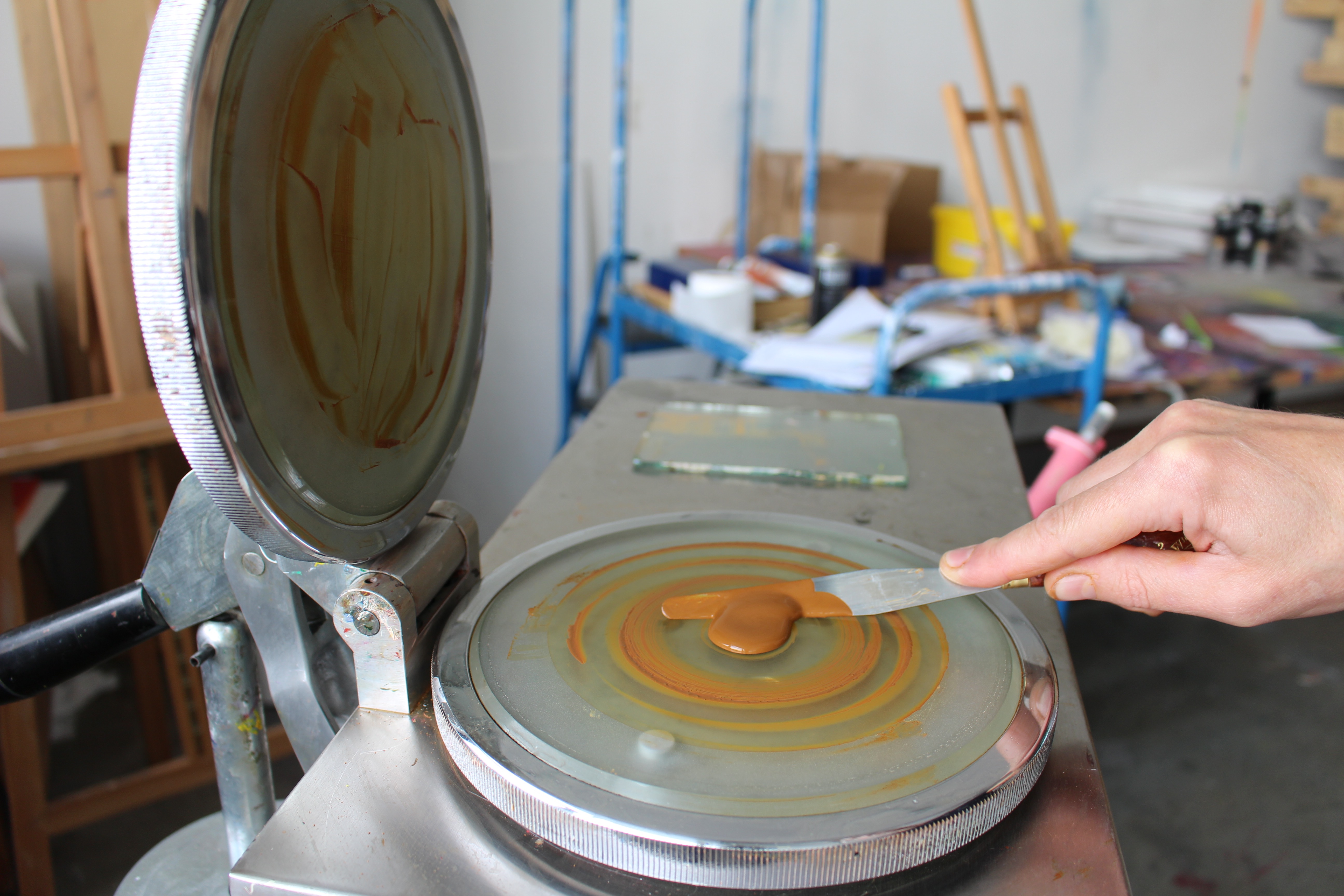
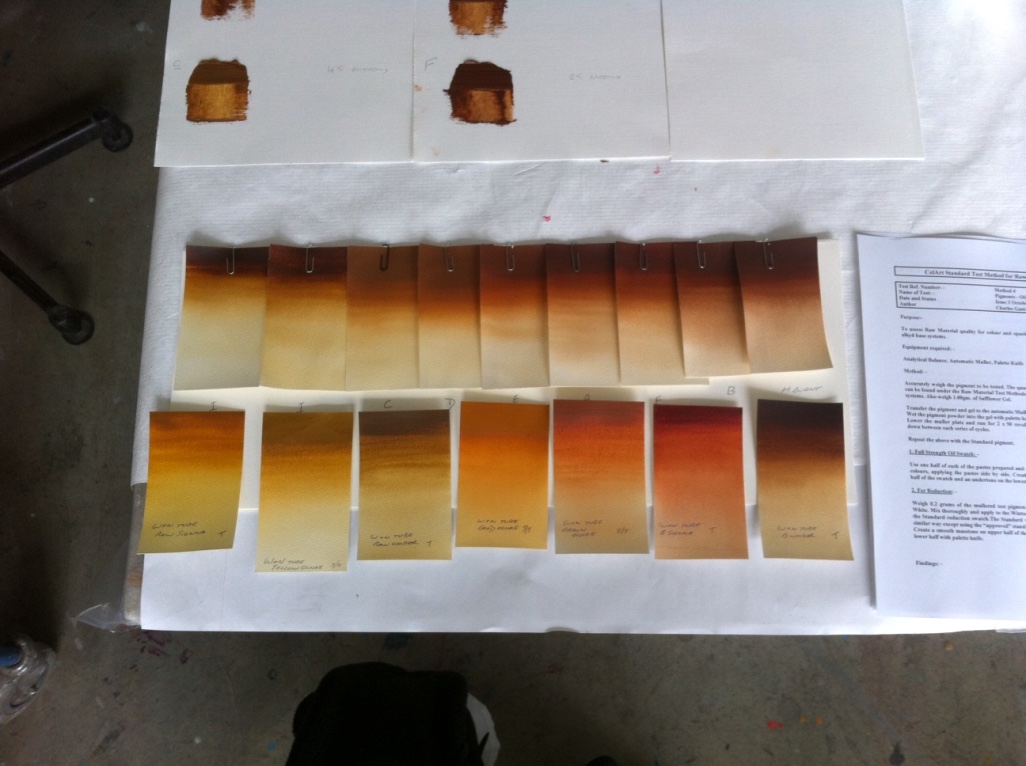
A Sustainable Pigment Factory
The focus of the work has turned to five sites where ochre is in formation - Six Bells and Tan-y-Garn mine water treatment schemes in South Wales together with three others in Scotland, Lancashire and North Yorkshire. These sites will become the first-ever functioning industrial sites to be associated with, and named as a sustainable source of colour: an incidental pigment factory. The sites and their colour will be recognised and acknowledged as part of the cultural, social and industrial history of the UK.
Water pumped from the flooding cavities of redundant coal mines inadvertently produces over 4000 tonnes of iron-oxide ‘ochre’ material as ‘waste’ ochre sludge every year. This largely untapped source of ochre presents an opportunity for the development of new earth pigment for use in paint that retains the identity of its material formation in the landscape. This is in contrast to currently available natural ochres from unsustainable unnamed sources across the globe.
The lakes of colour in the ground are the Mine Water Treatment Schemes run and managed by the Coal Authority. They inadvertently perform the production of ochre waste as part of the clean-up of polluting ground water and contaminated land. The lakes signify an event occurring in the post-industrial, post-carbon landscape and are defined and highlighted here as performing a cultural act and recognised as artworks.
Cultural Materials
The ochres are distinguished by the quality and indivudality of their colour that describes the particular conditions of their landscape context which are intricately linked to the history and legacy of the coal mining industry; to the hands that worked this industry. The use of the coal mine waste materials as pigment for paint recognises for the first time their position as part of the cultural landscape of the UK.
Over the past year we have been developing the project in consultaion with the particpants from the community at Ty Ebbw Fach / Six Bells Regeneration to collectively explore the value and significance of the materials for the people whose experiences are shaped by the mining landscape and its legacies. Beginning in January 2020 a number of public events have taken place, starting with meeting retired coal mine surveyors and workers who talked about their knowledge and memories of the mines.
This has been leading up towards the launch of the first ever mineral based wall emulsion paint and oil paint made in collaboration with two world class paint manufacturers local to the area.
The ongoing programme of work is developed through close collaboration with the Coal Authority.
Over the course of its evolution this work has had significant contributions from Dr. Ruth Siddall geologist and pigment analyst at UCL; Prof. David Dobson from the Department of Earth Science UCL, Jo Volley, Deputy Director (projects) Slade School of Fine Art and Spike Bucklow, Reader in Material Culture, University of Cambridge.
TLiC is the research site of artist Onya McCausland.
McCausland, O Turning Landscape into Colour 2017
For more updates on Colour from the Mines 2020 please follow the project on social media:
Website: https://onyamccausland.com/
Twitter: @turningland
Instagram: @onyawildermccausland, @onyamccausland
About Turning Landscape
Turning Landscape became a Community Interest Comany in 2020 and is based at Ty Ebbw Fach in the former mining village of Six Bells, Blaenau Gwent, South Wales to develop ochre minerals - that form in coal mining landscapes as a result of the end of mining - to turn these into pigments for use as paint. In October 2022 Turning Landscape received Heritage Lottery Funding to suppor a programme of events, workshops, talks and demonstrations that bring together people with interest in the social, economic and environmental legacies of coal mining and extractive practices.
The research was developed by Onya McCausland and is now run as a collective community project CIC with Lucy Harding and Hywel Clatworthy as co-directors. We have a working agreement with the UK Coal Authority (a non-departmental government organisation) who provide us with access to their mine water treatment works, and use of the residue materials these produce.

Frances Mine Water Treatment Scheme, Kirkcaldy, Fife, Scotland 2014
This research programme has involved intensive engagement with places where mining and quarrying is still shaping the landscapes to observe and document evolving knowledge of particular sites, their geology, the mineralogical peculiarities and the effect mineral extraction has on the contemporary landscape. Each ochre forming in each landscape is geologically distinct and can be seen as an index of a place - formed from the specific environmental, ecologic, geographic idiosyncrasies of that place only.
Six Bells and Abertillery with the mine water treatment scheme just visible in the lower middle of the picture 2020.
Overlaying the material effects of landscape are the cultural complexities that are woven so deeply into each landscape structure that they become inseparable; the geological, the social; the ecological and the economic. The questions this work considers are can the complicated interdependencies between humans and geology be signified by a unique paint derived from waste minerals that form during the treatment of mine water? And can these colour materials that are unique to place be used, repurposed to restore pride and connection between community and landscape?
The coal mine ochre colours have a different genesis from traditional ochres as they are being generated through the treatment of polluting ground water in ex-coal mining regions across the UK. The unique geological setting of the individual landscapes has a particular and unique influence on the waste minerals forming there. The discovery of these qualities has happened through making artworks that follow five individual ochres from their geological landscape contexts through physical transition into usable pigments for paint. A process that simultaneously exposes layers of sociopolitical history, along with the contemporary cultural and economic connections to place.
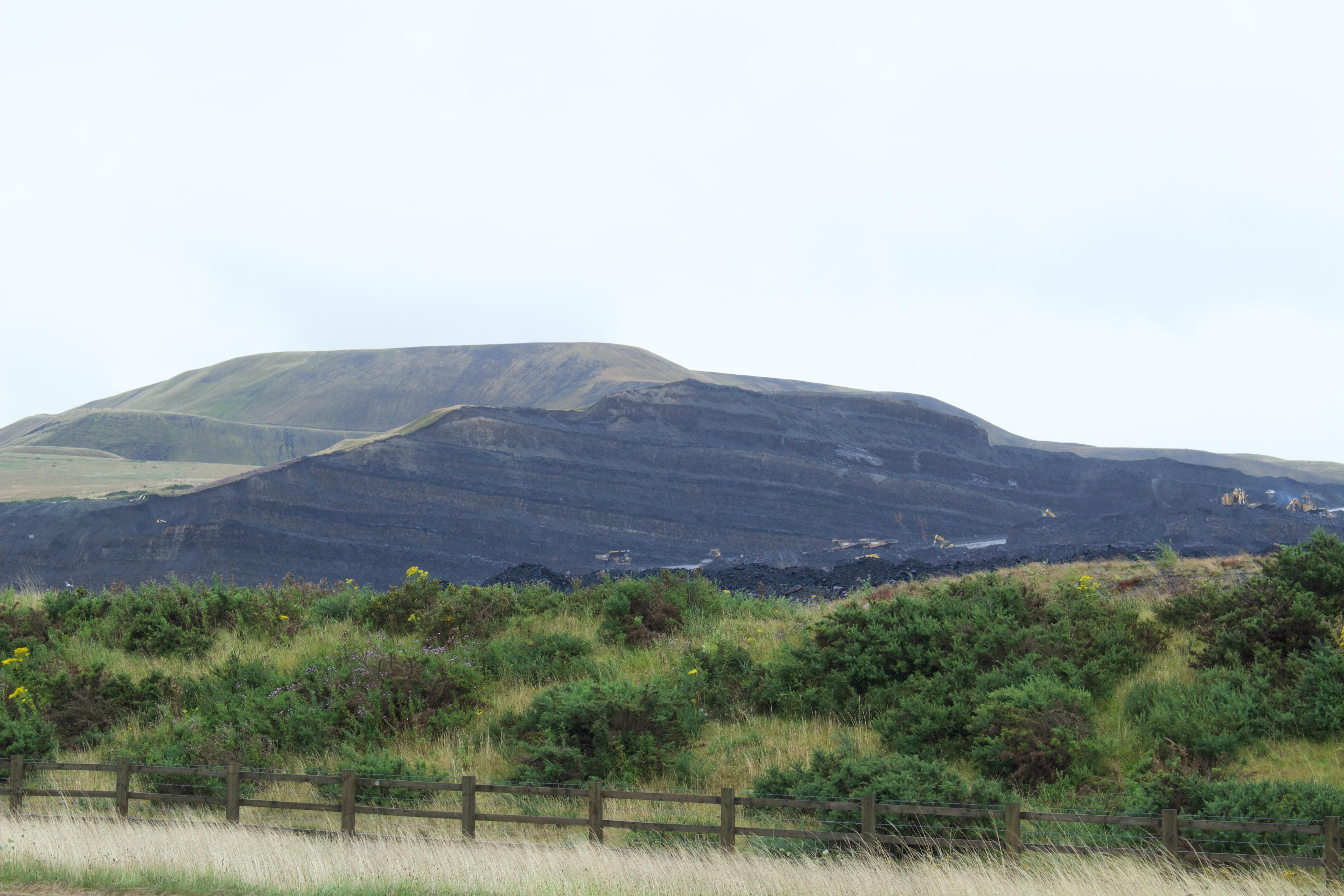 Photograph of Tower open cast colliery 2015. Coal extraction at the Tower opencast
site came to an end in 2017 after changes in environmental regulations.
Photograph of Tower open cast colliery 2015. Coal extraction at the Tower opencast
site came to an end in 2017 after changes in environmental regulations.Ochre is the oldest of cultural materials with roots stretching back to the beginning of human history. The mine water ochres can be aligned with traditional historic ochre - a mineral that has been found sprinkled on cave floors, caked onto the buried bones of ancient humans;1 mixed with binder and turned into paint on cave walls, some 30,000 years ago and forming patterns on the built walls of early human settlements at Djade al- Mughara, Aleppo, Syria 11,000 years ago.2
Environmental impact
The mine water ochres forming in the vast subterrainian wastelands of the coal mines contain and carry the significance of a geological, ecological and social event in time that point towards the contemporary condition of past human and geological extractive practices occurring in a particular place in the world at a particular time in history. This work attempts to explore the complexity of these conditions - local and global, that are combined in a specific material. This research repositions each ochre colour as a culturally significant material as an acknowledgment of its real and symbolic significance in a long evolving human story. These ‘new’ mine water ochres are presented here as human colours with a very specific cultural story and value.
Six Bells and Abertillery showing underground mine workings overlaid with surface topography and infrastructure
The research has developed and been informed through a focused practice of painting and its traditions, referring tothe earliest marks on cave walls, neolithic marks and the minimalist marks of the modernist / post modern traditions: Painting has been a line to follow and also to drift off from. Collaboration with chemists, earth scientists and paint manufacturers have helped to shape and understand the analytics of the material as pigment, from particle size, transparency and lightfastness, using x-ray diffraction, scanning electron microscopy (SEM) and cross polarised light microscopy, to drying, burning, grinding and sieving, scaling up, ratios of one medium to another to find a route to get a paint that carries the weight of the conditions of its formation, that can be applied to a wall.
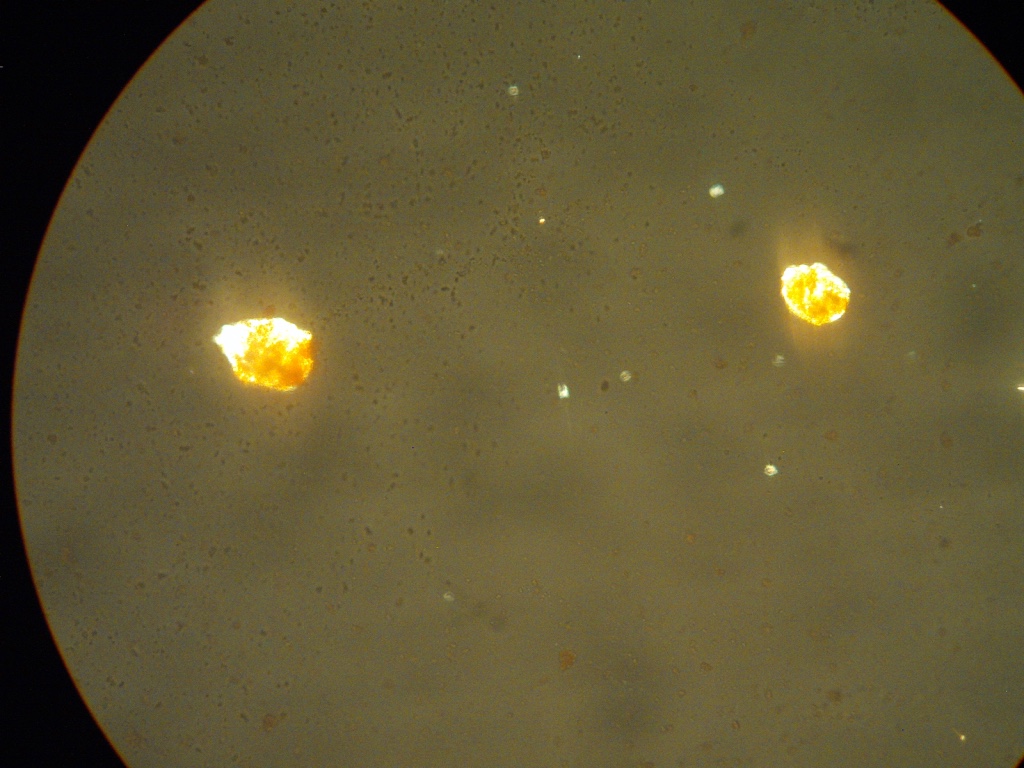
Cuthill ferrihydrite digital photograph using cross-polarised Light (XPL) x1000, field of view 0.1 mm.
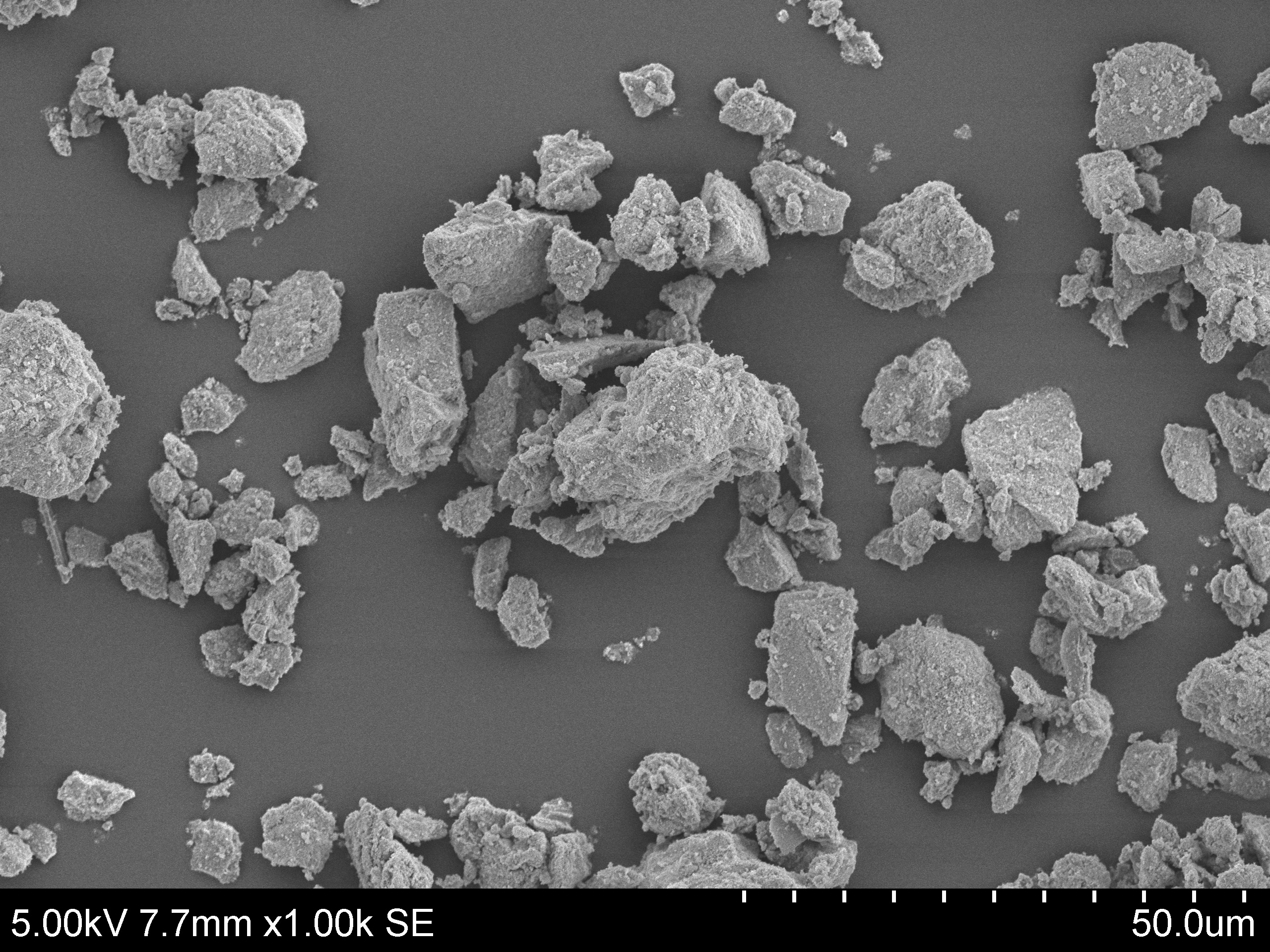
Scanning electron microscopy (SEM) Six Bells ochre
Coal Authority Video
In 2018 the Coal Authoity produced a short film oulining the processes involved in their mine remediation programme and ochre formation and how working with Onya McCausland brought new insight to the potential uses of mine water ochre for use in paint and how individual places produce different ochres colours. The film demostrtes the collaborative effort between Onya and the CA in working to change perception of the materials forming in the ex-mine sites.
Coming soon....
In the coming weeks we will be launching the very first sustainable exterior grade mineral based wall paints made from 100% coal mine ochres. And an amazing oil paint Six Bells burnt ochre made in collaboration with Michael Harding paints.
1 The Red Lady of Paviland: OUMNH Q.1. Visit to see the remains at Oxford Museum of Natural History 2016. One of the richest 1Palaeolithic sites in Europe is in South West Wales on the Gower Peninsula between Port Eynon and Rhossili. Sollas, W.J. The Journal of the Royal Anthropological Institute of Great Britain and Ireland, Vol.43 (Jul. - Dec., 1913)
2 National Geographic online: http://news.nationalgeographic.com/news/2007/10/photogalleries/wip-week50/photo7.html, accessed: 217th December 2014. And: Caroline Cartwright (2008) The World’s Oldest Wall Painting In Syria?, Palestine Exploration Quarterly, 140:1, 3-3, DOI: 10.1179/003103208x288645 http://dx.doi.org/10.1179/003103208x288645 Published online: 02 Dec 2013
Turning Landscape into Colour Abstract, link to PhD: https://discovery.ucl.ac.uk/id/eprint/10039744/
Further info on individual artworks www.onyamccausland.com
Ty Ebbw Fach/Six Bells Regen
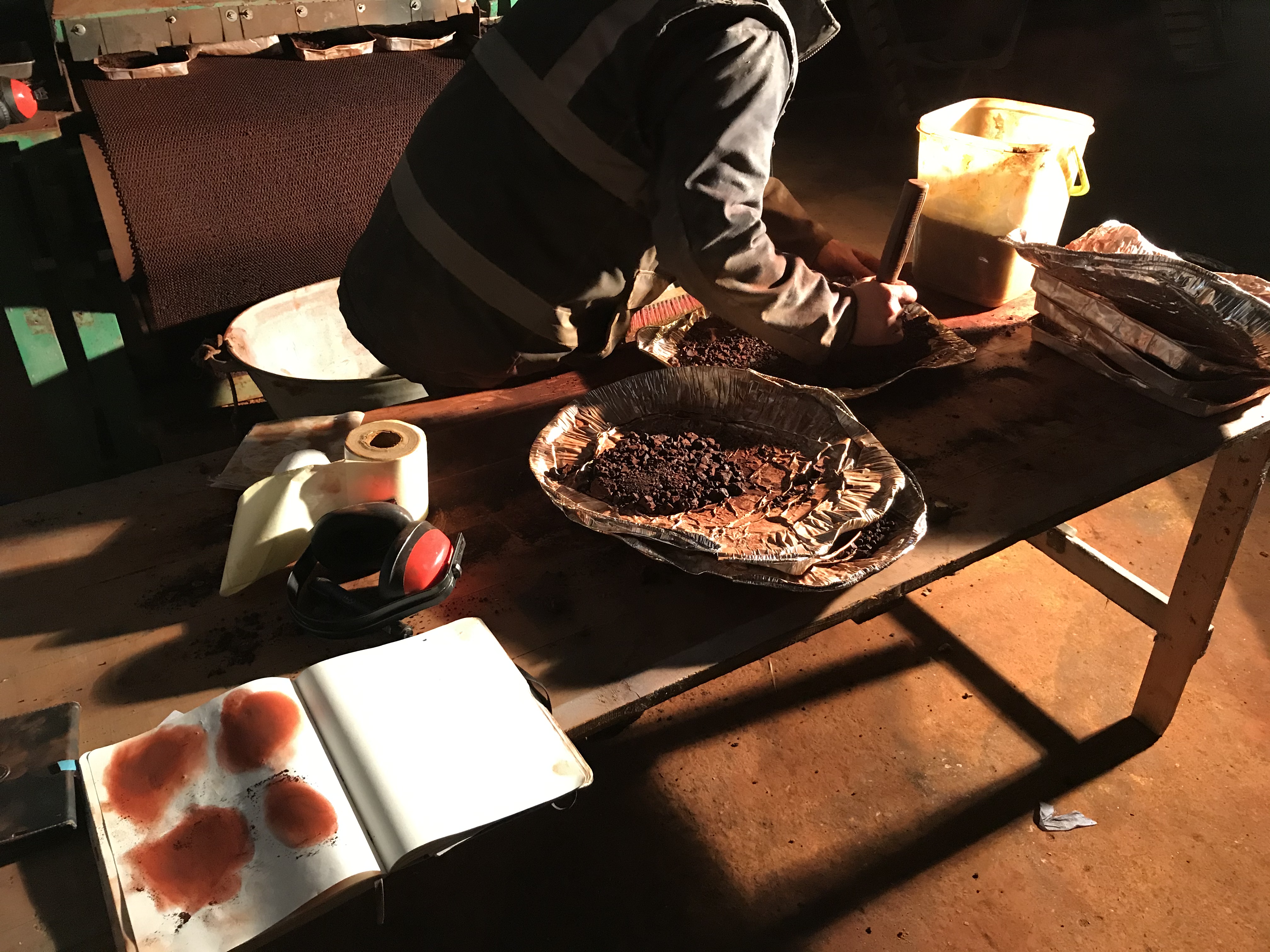
Six Bells Burnt Ochre
Six Bells in South Wales will be the first place in the UK where the new paint is made and named by its place of formation. In Autumn 2020 a first edition batch of specially prepared mineral based wall emulsion paint and an editioned run of oil paint made with Michael Harding Paints will be made available at Ty Ebbw Fach at Six Bells.
Six Bells Regeneration / Ty Ebbw Fach have been hosting online workshops, family group art workshops and discussion forums. These will lead towards a special public open day generously supported by the Coal Authority that will see the official naming of the new colour at its site of origin with the installation of a plaque at Six Bells Mine Water Treatment Scheme.
The collaboration between Onya McCausland, the local community through Ty Ebbw Fach at Six Bells and the Coal Authority draws attention to mining heretage that proposes these colours as a new alternative legacy.
Public Consultation Six Bells / Ty Ebbw Fach
This research was first introduced to the wider community at Six Bells in January 2020 at a well attended consultation event hosted at Ty Ebbw Fach (Six Bells Regeneration). It gave the public an opportunity to ask about the projects aims and ambitions and the potential impact on the local economy. The meeting was also attended by Jon Aumonier of the Coal Authority - the body responsible for the mine water treatment process and the day to day operation of the scheme - Jon conducted a walking tour around the perimeter fence of the Mine Water Treatment Scheme. The January event was followed by two further public meetings and plans for workshops through the spring and summer. Because of the Covid 19 several meetings and workshops had to be postponed.
The first group event was hosted by Ty Ebbw Fach when local miners and mine surveyors talked about their experience of the mines under Six Bells. An audio recording was made and this will feature shortly here.

Mining Surveyors
The second public group meeting took place in February at Ty Ebbw Fach. Local miners and mine surveyors attended and talked about their experiences of the mines directly under us at Six Bells. They brought maps of the mine working and we discussed the infrastructure and daily working of the mines as they recalled it.
An audio recording was made and this will feature shortly here.
Discussion with retired mine surveyors, Robert, Kerry, Bernard and Ray Feburary 2020
Online art workshops and tutorials
Despite the current Covid 19 crisis we are inviting local people to take part in the project online. Led by video tutorials we are inviting local residents to participate in walks and artworks using watercolour paint made from residues generated from the mine water treatment at the Six Bells scheme.


Preparing Watercolours

During March 2020 artist and printmaker Nichola Goff made up 4 watercolour sets, each with 4 different pigments from the mines. Each set is made up of individual watercolour pans using pigment from Six Bells (raw and burnt ochre) Tan-y-Garn ochre and Bideford black.
The watercolours were made during the first weeks of the Covid-19 pandemic as a way of compensating for not being able to run face to face art workshops. Each set was sent out to people living in the Six Bells area so they could try out using the colours first hand. Nichola made the following video demonstrations of the process of mixing the paints and how they look and feel different to use. The final video gives some guidance for those using the watercolours. Along with the watercolour sets we posted paper, brushes and note books asking that people record their experience of using the pigments.
The enthusiastic and moving response to this call out can be seen here:
Facebook : Colour From The Mines : https://www.facebook.com/groups/ColourFromTheMines
Six Bells Raw Ochre
Six Bells Burnt Ochre
Tan-y-Garn Raw Ochre Process
Bideford (Coal) Black
Demo: Watercolours sets demonstration
Watercolour sketchbook
